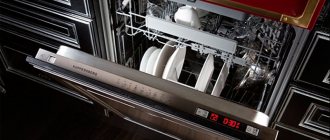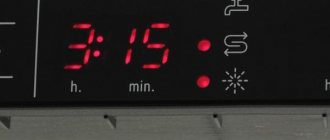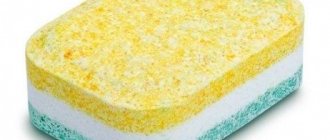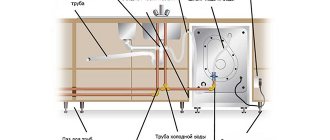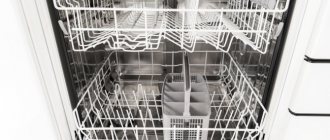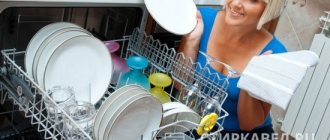/Household appliances/Built-in/
So, you bought a machine and are ready to trust it with washing dishes for the first time, or maybe you have been using it for a long time, but sometimes you are unhappy with the result? All kinds of forums are full of questions about what to do if the dishwasher (hereinafter we will sometimes call it PMM - for brevity) does not work well - it does not wash the dishes or leaves white stains on it. In most cases, the problem is not in the device at all, but in improper use. What is the correct operation of dishwashers?
How to start a dishwasher for the first time
Your dream has come true and you have become the owner of a brand new “dishwasher”. Before starting operation, carefully read the included instructions. There you will find all the necessary information on how to use your dishwasher.
Like most units, it is important to start the dishwasher correctly the first time. How to do it? The algorithm of actions is as follows:
- Open the wash chamber and make sure there are no stickers, stickers, foam or other foreign objects inside.
- Connect the unit to the network and open the tap to ensure the water supply.
- Use the set that most often comes with the dishwasher. It consists of powder or washing tablets, as well as special salt, which is necessary to soften the water. Pour salt into the desired compartment after filling it with water, and then add dishwasher detergent into the tray provided for it.
- Set the longest mode with the highest temperature.
- Run a “idle” wash cycle.
A special product will clean the dishwasher of dirt and factory grease. After the cycle is complete, leave the door open to “ventilate” the compartment.
How to properly fill PMM with salt?
To make tap water softer, each PMM has an ion exchanger that has a softening effect. In order for the ion exchanger to perform its functions, salt must be added to the machine on time. To find out in what quantity you need to add it, you need to find out and record the hardness of the water by entering the data into the machine’s memory.
You can find out the water hardness in your region at your local Vodokanal.
The best option is to buy a dishwasher that has an automatic hardness detection function. Such a machine will determine this parameter itself and calculate the required dose of salt. But such a PMM is not cheap - usually this function can be found in Premium segment models. So the best option is special test strips that will show approximate indicators, and this will be enough.
Features of using salt in PMM:
- The frequency of refilling depends on the hardness of the water in the region, as well as on the volume of water consumed by the device.
- They learn about the absence of a salt component thanks to the indicator. If the light comes on, it means it’s time to fill the compartment. The user does not need to remember when this component was filled in - the machine itself will report an empty compartment.
- Salt is loaded into the ion exchanger using the funnel that comes with it.
- When you first start the machine, water is poured into the ion exchanger and 1 kg of salt is added. There is no need to add water for subsequent refills. The consumption of the salt component does not depend on the number of cycles, but on the volume of water passed through the system.
How to turn on the dishwasher
After the “test run” you can begin to operate the equipment. How to use a dishwasher correctly? Follow these guidelines:
- Check the condition of rotating parts and filters, cleaning them if necessary.
- Before washing dishes and loading them into the wash compartment, clear the plates of food residues. Otherwise, the filter will become clogged.
- It is important to load the machine correctly. Carry out this work according to the instructions, without overloading the compartment.
- Add detergent and rinse aid, following the recommended dosage of cleaning compounds.
- Set the washing program according to the degree of soiling of the dishes.
This list may be supplemented with other tips, depending on the dishwasher model.
How to put salt in the dishwasher for the first time
How to put salt in the dishwasher correctly? When you use it for the first time, follow this sequence of actions when loading it:
- Fill the compartment provided for the product with water.
- Open the special valve and slowly add salt (you will need 550–600 g).
- If you spilled some of the substance, remove it from the surface.
- Close the valve.
- Start the unit.
The function of salt is to soften water. How often should you use it? This depends on the following factors:
- frequency of use of the dishwasher;
- degree of soiling of the dishes;
- hardness level of incoming water.
If the drug is not enough, this can be noticed by the indicator light, which goes out as the unit is “saturated” with salt. For machines not equipped with this function, backfilling is carried out once every 1–1.5 months.
Choosing detergents for the car
First, let's look at the issue of choosing detergents, because they can both ruin and significantly improve the operation of the PMM. There is a whole group of detergents that are needed at different times, for different purposes and in different doses.
Here is the list:
- Salt - allows you to soften hard water, dissolve calcium, thereby preventing the inside of the machine itself and the dishes from being covered with limescale. How often do you put salt in the dishwasher? This depends on the frequency of its operation and the hardness of the water, which varies in all regions. You need to focus on the salt indicator on the control panel: if it lights up, then it’s time to refuel your assistant. Salt is sold in a pack weighing 1 kg, on average 1 pack. enough for six months.
- Powder, gel, tablets are actually washing products. Of course, you can’t do without them, but sometimes you don’t need to use them, for example, in the rinse mode, when the dishes only need to be refreshed. You can also wash...vegetables without any products. For example, potatoes.
- Rinse aid – it scents the dishes, prevents the formation of streaks and helps to dry the dishes completely.
- Degreaser – prevents grease particles from settling on machine parts.
- Anti-scale – efficiently removes limescale, extending the service life of equipment. It is not used constantly, but approximately once a quarter.
And now more about some of the nuances.
Each of the listed detergents must be used correctly, accurately dosed and applied in accordance with the instructions.
The required amount of salt can be determined in three ways:
- Manually measure the water hardness and store the obtained data in a storage device;
- Check the information at the local water utility and enter it into the machine’s memory;
- Machines with an automatic sensor evaluate the hardness themselves with each water intake and, in accordance with this information, take the right amount of salt.
Salt is filled into the ion exchanger using a funnel, which is included in the kit.
- Before the first start, water is poured inside, and after that a large amount of salt (1000 g) is poured. In the future, only add detergent, and do not add water;
- Do not use table salt under any circumstances!
Almost all modern models are equipped with a sensor indicating the need to refill the ion exchanger. Salt consumption does not depend on the number of washing cycles, but on the water consumption per program, in liters.
As for detergents, you need to keep in mind that the powder consumption is also controlled by special sensors (if the machine has this function). If it is not there, then you will have to load the powder “by eye”, following the manufacturer’s instructions.
- The powder can only be poured into a dry tray;
- Powder is more effective than tablets, as it dissolves better, is suitable for short programs, and in addition, it is more economical to use, since you can control the amount of powder yourself.
As for the tablets, they will help wash dishes only when setting long cycles, since in short programs they do not have time to dissolve. In addition, each type of tablet is designed for specific water hardness levels. Some manufacturers indicate that when using tablets, the water hardness values in the program should be reduced. Tablets such as “3 in 1”, “4 in 1”, etc. consist of several multi-colored layers, each of which performs its own function: washing, water softener, rinse aid, etc.
Speaking of mouthwash. As we have already said, it is needed for crystal shine and better drying. It is also consumed according to the dispenser, that is, you need to fill the liquid to the very edge, but with the help of the regulator you can determine the consumption of the product yourself for each wash.
- Keep in mind that the incorrect proportion of rinse aid and salt will cause stains on the dishes.
- First try washing dishes with rinse aid at 4;
- If the dishes remain wet, increase the dose;
- If the dishes dry well, but stains appear, reduce the rinse aid level;
- In principle, rinse aid is not necessary for use, unlike salt and detergents.
How to wash dishes in the dishwasher
Special products are used for dishwashers; using regular powder, soap or gel is unacceptable.
As a rule, compositions for such units are available in the form of powders and tablets. When using powdered products, 20–30 grams of the composition are needed for one wash cycle, while tablets are used 1 piece at a time.
According to housewives, the second option is the most convenient and profitable, since it combines a cleaning agent, a rinse aid that speeds up drying, and softening salt. Their only drawback is that they are ineffective for gentle regimes, in which case the tablet does not have time to dissolve.
Do not overuse detergents; follow the dosage indicated in the instructions.
Why does a dishwasher need salt?
A special salt intended for dishwashers softens tap water to more effectively wash dishes and prevent the formation of scale in the body and parts of the PMM. The main function of salt compositions is the restoration of chlorine ions in ion exchangers that prepare water for use in dishwashers. How it works?
Hard tap liquid is initially rich in alkaline earth metal ions such as potassium and magnesium. Under the influence of high temperatures, magnesium-potassium salts are formed, which are deposited in the form of scale and limescale on the surfaces of PMM parts.
Hard water forms scale, which is the worst enemy of washing machines and dishwashers.
Scale reduces thermal conductivity and shortens the service life of dishwashers. To prevent its formation, liquid from the water supply is passed through an ion exchanger, which binds magnesium and calcium ions with chlorine ions found in a synthetic ion exchange resin. This is how water is softened, as a result of which it is purified of unnecessary impurities, losing its hardness.
Sodium chloride reduces chlorine ions in the ion exchanger
During operation, chlorine ions need reduction, which successfully occurs thanks to a specially prepared salt, which is 98% sodium chloride, or sodium chloride, its formula is NaCl. The remaining ingredients are polyaspaginate to restore and preserve ions, dishwasher sanitizing sodium citrate, fragrances and other beneficial additives.
Readers may ask: why use a special compound when you can use simple kitchen sodium chloride? Unfortunately, you cannot use regular table salt, because it contains a lot of foreign impurities, and they are harmful to the dishwasher just like scale.
In the kitchen salt composition, even with the naked eye you can see dark spots of impurities that are dangerous for washing units
In addition to extending the service life of the PMM, softened water performs other useful work:
- improves the process of washing dirt and food debris from the surface of the dishes;
- maintains the thermal conductivity of the surface of the electric water heater at the required level.
Many models of modern dishwashers from Bosch, Siemens, Electrolux and other well-known brands have sensors that notify users of insufficient sodium chloride. In this case, the salt composition must be immediately added to the PMM.
Sodium chloride reservoir with ion exchanger used in Bosch PMM
Finish tablets for the dishwasher: how to use
Probably the most popular “dishwasher” composition is “Finish” tablets, which include compressed powder and a capsule with gel in the middle. Upon contact with water, the product dissolves and washing occurs.
How to use this product correctly? Remember the following rules:
- Place the tablet only in the dry compartment, this will allow the product to soak evenly.
- When loading dishes, make sure that no objects obstruct the opening of the tray, otherwise the detergent will not get inside.
- If you have loaded dishes with heavy tea deposits on them, take care to reduce the water hardness, otherwise the stain will not be washed off. For these purposes, special salt is used.
- When washing glassware, you can pour vinegar or a solution of citric acid into it, this will add additional shine. But if you are using finish all-in-1 tablets, this is not necessary because they contain the necessary ingredients.
- To extend the life of your “assistant”, use a special “Finish” product every six months for preventative cleaning.
Compliance with these rules will allow you to wash dishes efficiently and maintain the operating condition of the unit at the proper level.
How to use the rinse aid?
This component is not required for use. But desirable. It can be added as desired. The absence of rinsing agent does not affect the condition of the PMM, only the final appearance of the washed dishes. How much rinse aid to pour in is determined by the dispenser - a special scale with marks.
If the proportions of the detergent composition and rinse aid are still violated:
- and after drying the dishes remain wet, it is necessary to rinse the utensils and increase the amount of rinse aid - fill the composition up to about;
- If stains appear on the dishes, the dose of rinse aid, on the contrary, needs to be reduced.
If the proportions of rinse aid and powder are incorrectly calculated, whitish stains will remain on the dishes after washing. There is no such danger when using tablets.
How to properly load dishes into the dishwasher
To ensure high-quality washing, it is important not only to handle the unit carefully and use effective detergents, but also to load it correctly. This should be done like this:
- Remove any leftover food from the plates and, if necessary, pre-rinse the dishes to remove excess grease.
- First, place large plates inside closer to the grid, and small ones in the central part, this way you will save space. If the dishes are very dirty, place them not in each compartment, but every other.
- Place the pan so that its handle rests against the plate, otherwise it will interfere with the operation of the unit.
- Place mugs, glasses and glasses upside down to prevent dirty water from getting inside.
- Place the devices in the tray provided for them. If there is no such tray, place them in the central part of the compartment.
Close the door tightly, add the necessary products, set the desired mode and start the washing cycle.
What dishes should not be washed in the dishwasher?
For all its advantages, a dishwasher is not capable of washing everything. There are materials that are strictly prohibited from being subjected to automatic washing. These include:
- aluminum (oxidizes under the influence of detergents);
- silver, copper, tin, lead (tarnishes and becomes stained);
- cast iron, coated with enamel or without non-stick coating (rust forms quickly);
- crystal (loses its shine and becomes cloudy);
- earthenware and porcelain decorated with patterns or gilding (drawings are damaged);
- wood that is not coated with water-repellent compounds (it dries out and becomes unusable);
- plastic that does not have proper heat resistance (deforms, sometimes changes color).
Do not load items into the unit that have traces of paint, candle wax or ash on the surface.
Products offered in the retail chain
Today, the choice of household chemicals intended for dishwashers is very large. In this variety, salt is presented in the form of granular and crystalline bulk compositions, as well as in the form of tablets.
The most common type of sodium chloride for dishwashers comes in the form of crystals or granules.
Many companies produce these drugs. The most famous of them are Finish, Calgonit, Topper, Somat, Start, Magic Power. Users willingly purchase products from brands such as Clean & Fresh, Paclan Brileo, Top House and other lesser-known manufacturers.
Manufacturers claim that tableted salt for dishwashers lasts 1.5 times longer than crystalline salts.
Sodium chloride in tablet form is produced under the brands Topper, Frau Schmidt, Dr Prakti, Kristall-fix, Lotta and others. As a rule, manufacturers indicate the dosage of the product on the packaging. Purchasing household chemicals for dishwashers is not difficult - all the necessary components are widely represented in the retail chain.
How to replace dishwasher salt
If for one reason or another you do not use special salt, you can soften the water for the dishwasher in other ways.
When you just want to save money, use regular table salt. However, you should know that this is unsafe for the car for a number of reasons.
Despite the fact that the active ingredient is identical (sodium chloride), the special product is purified and does not contain large granules, which cannot be said about the “food” version. Using table salt, you can damage the machine, and you won’t be able to save money, since you will need to pay for repairs.
If you still decide to use regular salt, take only “Extra”, which has been purified and has a more uniform composition, without large particles. In addition, it must first be dissolved in water.
You can use 3-in-1 tablets or mouthwash for these purposes. The price of these products is not inferior to special salt, but the effectiveness may be lower. In addition, the use of substitutes entails certain inconveniences, namely:
- if the product is replaced, the warranty for the “dishwasher” ceases to apply;
- the quality of water softening decreases;
- other products will have to be used much more often than a special composition (and if you use table salt, this must be done before each dishwashing).
Therefore, it is better not to experiment with expensive equipment, but to use special products for the dishwasher.
How to fill a Bosch dishwasher?
The nuances of refilling PMM depend on its brand and internal design. But in general the process is the same everywhere. If something is unclear, for example, where this or that compartment is located, how to open it, etc., you should read the technical instructions.
How to refuel a Bosch machine:
- The powder is loaded into a special dispenser. Do not pour it directly into the chamber.
- The rinse aid is poured into a separate compartment. It is not poured before every wash. When it ends, the indicator will work.
- At the bottom of the chamber there is a round, screw-on lid. It is unscrewed to pour salt into the container. Enough granules are poured in so that about 1 cm remains to the edge.
If your dishwasher doesn't wash dishes
If the dishwasher begins to wash dishes poorly, the reasons may lie not in the poor quality of the unit, but in other factors.
Incorrect operation
Common mistakes when using such units are:
- “overloading” the washing compartment and placing a large amount of dishes;
- incorrectly set mode;
- errors when placing dishes in the compartment.
To avoid problems, carefully read the instructions before starting to operate the unit.
Blockages and scale
Like any washing machine, the dishwasher can become clogged. Check the following parts for problems:
- mesh and bulk filters;
- sprinklers;
- tank and heating element.
Regularly check these parts for contamination, and also do not forget about preventive cleaning of the machine with special products.
Incorrect use of detergents or their poor quality
If you have recently changed the composition with which you wash dishes, you can rest assured that this is where the problem lies. In other cases, the following reasons are possible:
- the appearance of streaks and plaque indicates that the recommended dose of rinse aid has been reduced;
- white streaks on plates and pots appear when the salt compartment is not tightly closed;
- The dishes remain greasy due to a lack of solvents.
In such a situation, you will need to adjust the “wrong” amount of detergent. And the problem will be solved.
Parts breakdowns
If, as a result of eliminating the listed factors, the machine does not work better and also does not wash well, the reason may be hidden in the breakdown of the following parts:
- electric heater (heater);
- sprinkler impellers;
- water turbidity sensor;
- recirculation pump;
- temperature sensor (thermal relay);
- malfunction of the control module.
In such cases, do not try to carry out repairs yourself; it is better to turn to professionals.
How to use cleaning compounds?
To prevent scale, mold, and fat deposits from forming inside the machine, it must be thoroughly cleaned quarterly. To do this, you can use various special products, for example Finish or Somat Machine Cleaner. They remove grease, clean pipes, filters, sprinklers, hoses, pipes, and remove scale.
All these compounds are poured into the powder compartment and one short cycle is launched or, on the contrary, the longest and most powerful one - the choice depends on the cleaner used. The machine must be empty during cleaning.
Is it beneficial to use a dishwasher?
A dishwasher can greatly facilitate the work of a housewife, but is this purchase really worth it?
Do not forget that we are talking not only about the cost of purchasing the unit, but also about the need to purchase special detergents and energy consumption. In addition, there will be costs for equipment maintenance, preventive cleaning, and in case of breakdowns, repairs and the purchase of new spare parts.
Thus, it is advisable to purchase expensive equipment in the following cases:
- if your family consists of 4 or more people;
- when there are frequent water interruptions in your home;
- in cases where the housewife spends a lot of time at work and very little time at home;
- if there are elderly or disabled people in the family who find it difficult to keep the dishes clean on their own.
It is up to the housewife to decide whether to purchase a “dishwasher” or not. But when making a decision, it should be taken into account that none of the owners of this unit regretted their purchase.
Some tips
A dishwasher is an expensive unit and it is better to take care of it regularly. Therefore, many users ask the question, which of the popular detergents are best suited for the dishwasher? Here are some rules that will save your unit:
- Standard gels with which we wash dishes by hand are absolutely not suitable for the dishwasher;
- The best recommended products are those with enzymes. They perfectly wash any metal pan, glass or ceramics even at low temperatures. This also applies to oxygen agents;
- It is better to purchase products without chlorine ingredients and other aggressive substances - phosphates and bleaches;
- Never forget about the mandatory reduction of water hardness - ensure there is a sufficient amount of salt to ensure ionic processes;
- You should not purchase questionable products at a low cost.


